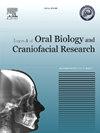Efficacy of Polydeoxyribonucleic Acid (PDRN) in periodontal regeneration: A systematic review of clinical outcomes
Q1 Medicine
Journal of oral biology and craniofacial research
Pub Date : 2025-04-09
DOI:10.1016/j.jobcr.2025.03.021
引用次数: 0
Abstract
Background
Periodontal disease is a major dental health concern due to its impact on the supporting structures of teeth, including the alveolar bone and periodontal ligament. Polydeoxyribonucleic Acid (PDRN) has shown promise in promoting tissue regeneration through anti-inflammatory effects and angiogenesis, crucial for periodontal healing.
Objective
To evaluate the clinical effectiveness of Polydeoxyribonucleic Acid (PDRN) in periodontal regeneration through a systematic analysis of available studies.
Methods
This review followed PRISMA guidelines and included randomized controlled trials (RCTs), cohort, and case-control studies assessing PDRN's effects on periodontal regeneration. A comprehensive search in PubMed, Scopus, Web of Science, and Embase was conducted using keywords related to PDRN and periodontal regeneration. Primary outcomes included clinical attachment level (CAL) gain, probing depth reduction, and bone fill. Two reviewers independently assessed study eligibility and extracted data on PDRN application methods, dosages, and observed outcomes.
Results
Among the four studies that met the inclusion criteria, significant improvements in CAL, bone fill, and probing depth reduction were consistently observed in PDRN-treated sites compared to controls. Animal studies also demonstrated enhanced bone quality, reduced inflammation, and a conducive environment for cell proliferation. Clinical trials indicated that PDRN, as an adjunct to conventional therapy, produced more favorable outcomes in periodontal healing. PDRN's activation of adenosine A2A receptors and VEGF expression promoted angiogenesis and modulated inflammatory responses, aiding regeneration.
Conclusion
PDRN appears to offer substantial benefits in periodontal regeneration by enhancing bone and tissue healing and reducing inflammatory responses. While promising, further clinical trials are necessary to determine optimal dosing and long-term effectiveness. This systematic review provides evidence supporting PDRN as a potential adjunctive treatment for periodontitis, with implications for enhancing clinical outcomes in periodontal therapy.

聚脱氧核糖核酸(PDRN)在牙周再生中的疗效:临床结果的系统回顾
牙周病是一个主要的牙齿健康问题,因为它影响牙齿的支撑结构,包括牙槽骨和牙周韧带。聚脱氧核糖核酸(PDRN)已显示出通过抗炎作用和血管生成促进组织再生的希望,这对牙周愈合至关重要。目的通过对已有研究的系统分析,评价聚脱氧核糖核酸(PDRN)在牙周再生中的临床效果。方法本综述遵循PRISMA指南,纳入随机对照试验(rct)、队列和病例对照研究,评估PDRN对牙周再生的影响。在PubMed, Scopus, Web of Science和Embase中使用与PDRN和牙周再生相关的关键词进行了全面的搜索。主要结果包括临床附着水平(CAL)增加、探探深度减少和骨填充。两位审稿人独立评估了研究资格,并提取了PDRN应用方法、剂量和观察结果的数据。结果在符合纳入标准的四项研究中,与对照组相比,pdrn处理部位的CAL、骨填充和探探深度减少均有显著改善。动物研究也证明了增强骨质量,减少炎症和有利于细胞增殖的环境。临床试验表明,PDRN作为常规治疗的辅助,在牙周愈合方面产生了更有利的结果。PDRN激活腺苷A2A受体和VEGF表达,促进血管生成,调节炎症反应,帮助再生。结论pdrn通过促进骨和组织愈合和减少炎症反应,对牙周再生具有显著的益处。虽然前景看好,但需要进一步的临床试验来确定最佳剂量和长期疗效。本系统综述提供了支持PDRN作为牙周炎潜在辅助治疗的证据,对提高牙周治疗的临床效果具有重要意义。
本文章由计算机程序翻译,如有差异,请以英文原文为准。
求助全文
约1分钟内获得全文
求助全文
来源期刊

Journal of oral biology and craniofacial research
Medicine-Otorhinolaryngology
CiteScore
4.90
自引率
0.00%
发文量
133
审稿时长
167 days
期刊介绍:
Journal of Oral Biology and Craniofacial Research (JOBCR)is the official journal of the Craniofacial Research Foundation (CRF). The journal aims to provide a common platform for both clinical and translational research and to promote interdisciplinary sciences in craniofacial region. JOBCR publishes content that includes diseases, injuries and defects in the head, neck, face, jaws and the hard and soft tissues of the mouth and jaws and face region; diagnosis and medical management of diseases specific to the orofacial tissues and of oral manifestations of systemic diseases; studies on identifying populations at risk of oral disease or in need of specific care, and comparing regional, environmental, social, and access similarities and differences in dental care between populations; diseases of the mouth and related structures like salivary glands, temporomandibular joints, facial muscles and perioral skin; biomedical engineering, tissue engineering and stem cells. The journal publishes reviews, commentaries, peer-reviewed original research articles, short communication, and case reports.
 求助内容:
求助内容: 应助结果提醒方式:
应助结果提醒方式:


